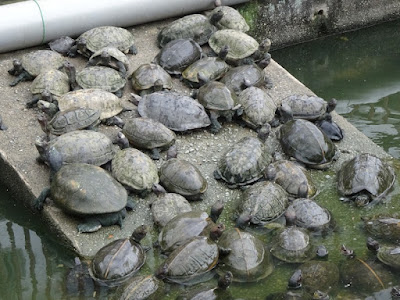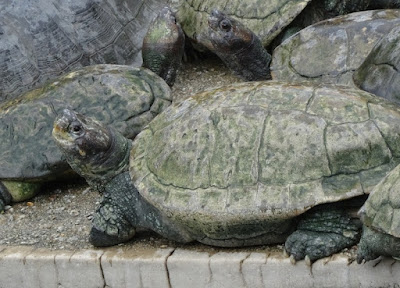Perched on a hill above Georgetown, on Penang Island, is Kek Lok Si, the largest Buddhist temple in Malaysia. The temple, first built in 1890, is both a destination for the devout and a tourist attraction.
It's a colourful and spectacular place, well worth a visit.
It might seem, however, an odd subject for a naturalist's blog. Certainly when Eileen and I visited it with her cousins Chris and Susan Chang, on January 15, 2015, I was expecting a purely cultural attraction. I was not aware (though perhaps I should have been) that a central feature of Kek Lok Si is a large, murky green pond crammed full of turtles.
Turtle 'liberation' ponds are a feature of Buddhist temples throughout Southeast Asia. Releasing a turtle (even if only into an escape-proof temple pond) is an act of merit, and turtles symbolize longevity and strength for the Chinese. Temples in a number of Asian countries have heavily-stocked turtle ponds, sometimes including species that, in the outside world where turtles fetch increasingly high prices, have become very rare indeed.
Unfortunately, that same rise in prices has made temples like this one a target for thieves. In 1998, 250 "tortoises" (which may have been freshwater turtles, as these are what fills the pond today) were stolen from Kek Lok Si itself.
The overwhelming majority of the inhabitants of Kek Lok Si's turtle pond were Giant Asian Pond Turtles (Heosemys grandis), a species that ranges from Thailand to Peninsular Malaysia [and while I'm at it, a big thank you to my friend, and noted turtle specialist, Peter Paul van Dijk for checking my identifications]. Its shell can range up to half a metre in length. Younger individuals have a characteristic stripe down the centre of the carapace, but (like the markings on most turtle shells) tends to disappear with age.
These animals, in fact, are so frequent in liberation ponds that they are also known as Orange-headed Temple Turtles (to distinguish them from the Yellow-headed Temple Turtle (H. annandalii)). You can clearly see the orange speckling on the head of this one.
Though Giant Asian Pond Turtles dominated the collection, other species found their way in among them. The small black individual at the bottom left of this photo is a Black Marsh Turtle (Siebenrockiella crassicollis), a widespread species found (though not easily, these days) from Vietnam to Sumatra, Java and Borneo.
Peeking out from behind the large turtle at the lower left is a Southeast Asian Box Turtle (Cuora amboinensis), a widespread and still relatively common species.
The Southeast Asian Box Turtle is the only one of the turtles I found at Kek Lok Si that I have seen in the wild, both in Sarawak and in Singapore. Its striped head makes it easy to identify (and, for North Americans, I might as well add that this and its fellow Asian box turtles are not close relatives of the box turtles of North America. Instead they belong, with all but one of the other turtles in this posting, to a separate family of largely Asian turtles (with a few in Europe and tropical America), the Geoemydidae.
Given the rapacious demand for turtles in the markets of China and other Asian countries, no turtle on the continent can be considered safe in the wild. A few of the turtles at Kek Lok Si, though, are now so rare that a temple pond like this one risks becoming the only place left to find them. You can see one of these much-harried creatures at the upper left of this picture.

It is a Southern River Terrapin (Batagur affinis), listed (with its close relative the Northern River Terrapin (B. baska), with which it was once included) as Critically Endangered by IUCN and as one of the twenty-five rarest turtles in the world by the IUCN Tortoise and Freshwater Turtle Specialist Group (TFTSG). Behind this one is a Painted Terrapin (Batagur borneoensis), a close relative, also Critically Endangered. These are large turtles of tidal river estuaries and mangrove forests, able to tolerate brackish water but highly susceptible to pollution and the destruction, through dredging and other activities, of the sandbars where they nest.
Male Batagur terrapins undergo a transformation in the breeding season that rivals that of some birds. This Painted Terrapin has begun its seasonal colour change at the head end. When complete, its carapace will be pale olive-grey, setting off the three broad black streaks running down its length.
Southern River Terrapins turn entirely jet black
on their heads, necks, legs and sometimes their
whole bodies. Their irises change from
yellowish to pure white.
All of the river terrapins have been persecuted to the point of extinction. Besides destruction of their habitat, they have suffered from overcollecting, particularly of their eggs; the Painted Terrapin is valued as a god luck charm. There have been ongoing efforts at captive breeding and reintroduction of the Southern River Terrapin, most recently in Cambodia where the species was once thought to be extinct.
A temple pond is a good place to see these rarities; it is no substitute for a management program in proper habitat, coupled with strict enforcement of laws against poaching and smuggling.
I mentioned that one turtle at Kek Lok Si did not belong to the widespread, largely Asian family Geoemydidae. this is it: the Pig-nose Turtle (Carettochelys insculpta), sole living member of its own family, the Carettochelyidae. It is not even Asian: its natural range is the Fly River basin of southern New Guinea and the still rivers and ponds of Australia's Northern Territory. Pig-noses and their eggs are traded out of New Guinea in vast, and surely unsustainable, numbers. They are one of the most popular pet turtles in Malaysia, so it was no surprise to see one here.


Should the turtles at Kek Lok Si be there? There is certainly a case that the desire to release a turtle into a temple pond, though noble in conception, may actually act against turtle conservation by creating a demand for turtles to be taken from their natural habitats to supply the demand for animals to set free - if release into an overcrowded, cement-lined pond can be so described. Fortunately there are better options in Malaysia, particularly Dr. Chan Eng Heng's long-term river terrapin conservation project on the other side of the Peninsula in Terangganu. I hope to visit it one day; in the meantime, though, the turtles at Kek Lok Si, though hardly in natural surroundings, will have to do.


























Wow, never knew that there were so many different kinds of turtles in the pond. Btw, the original pond is now the building in the first picture, so the pond was huge in the past.
ReplyDeleteI didn't know that - interesting!
ReplyDeleteThere are one or two Bornean Giant Turtles (Orlitia borneensis), a Yellow-Headed Temple Turtle and the odd spiny-Hill Turtle if one looks hard enough.
ReplyDeleteThere are also Giant Bornean River Turtles (Orlitia borneensis), a Yellow-Headed Temple Turtle and the occasional Spiny Hill-Turtle and Flat-Shelled terrapins.
ReplyDelete